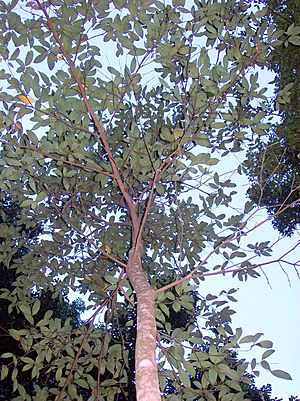Dorrigo plum facts for kids
Quick facts for kids Dorrigo plum |
|
|---|---|
 |
|
| Scientific classification | |
| Genus: |
Endiandra
|
| Species: |
introrsa
|
The Dorrigo plum is a special and rare tree found in the rainforests of eastern Australia. It's also known as the red plum or red walnut. Even though it's called a "plum" or "walnut," it's actually part of the laurel family, like the trees that give us bay leaves or cinnamon!
This amazing tree is quite rare. It grows mostly in higher areas, over 300 meters above sea level. You can find it from near Dorrigo in New South Wales up into Queensland. Its scientific name, Endiandra introrsa, has a cool meaning: "introrsa" tells us that the tiny openings on its flower parts, called anthers, face inwards.
Contents
What Does the Dorrigo Plum Look Like?
The Dorrigo plum is a tall tree, reaching up to 40 meters high. That's about as tall as a 10-story building! Its trunk can be quite wide, up to 90 centimeters across. The bark is reddish-brown and might have some bumps or dips, but the trunk itself is mostly straight. Even the small branches are covered in soft, downy hairs.
Its leaves are simple and usually grow one after another along the stem. They are shaped like an oval with a pointed tip, about 5 to 9 centimeters long and 1.5 to 3.5 centimeters wide. The top of the leaf is shiny green, while the underside is a waxy, grayish color. You can easily see the yellow veins on both sides of the leaf. The leaf stem is about 10 to 12 millimeters long.
Flowers and Fruit
Small, yellowish-green flowers appear on the tree between October and November. These flowers grow in clusters that are shorter than the leaves, usually from where the leaf meets the stem.
The fruit of the Dorrigo plum ripens from January to March. It's a large, fleshy fruit, like a drupe, about 3 to 6 centimeters wide. It's usually round, but often wider than it is deep. The fruit starts red and turns almost black when it's fully ripe. It looks a lot like a plum, which is how the tree got its common name! Inside each fruit, there's a single large seed.
Growing New Trees
If you want to grow a new Dorrigo plum tree from a seed, you should remove the fleshy part of the fruit first. The seeds are slow to sprout, but they are usually reliable. They start to germinate after about five or six months, and the process finishes a few months later.
Amazing Chemistry
Scientists have found a special substance in the Dorrigo plum tree called Endiandric acid C. This acid is very interesting because it's reported to have strong antibiotic properties. In fact, some studies suggest it might even be better at fighting bacteria than a common antibiotic called ampicillin! This shows how much we can learn from nature.

